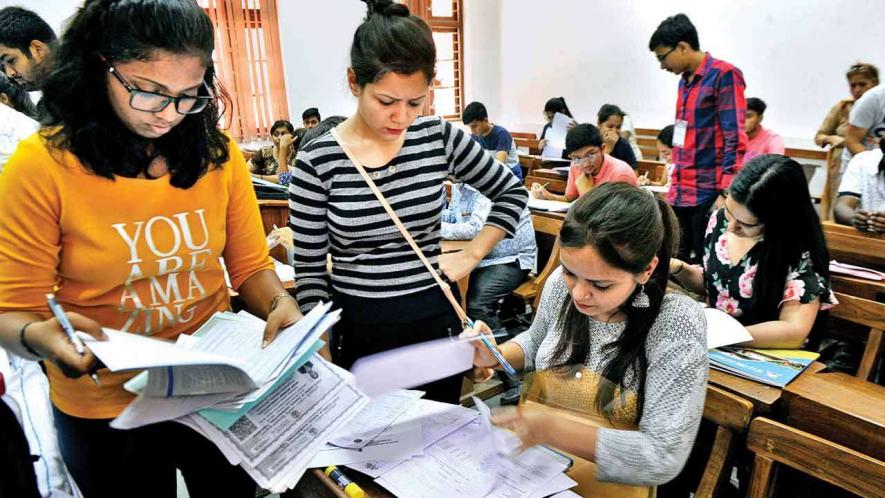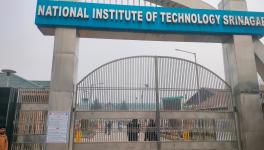Modi Government’s Years Are Marked by Attacks on Higher Education

Representational Image. Image Courtesy: DNA India
The years of Modi government have been marked by continuous attacks on public-funded higher education. Teachers and students from universities and colleges across the country have time and again protested against the shrinking autonomy of public universities, the lack of funds in several universities, seat cuts in various courses ranging from undergraduate to PhDs, and against replacement of the University Grants Commission (UGC) with the new Higher Education Commission of India (HECI). The Modi government has also replaced grants to public universities with infrastructure loans via the Higher Education Finance Agency (HEFA).
Since the NDA government came to power for the first time in 2014, the UGC started slowly introducing guidelines and regulations that curtailed the autonomy given to the universities, like their powers to independently frame syllabi, course structures, and admission policies. In June 2017, the UGC introduced a new scheme that instead of restoring these freedoms, allowed colleges to establish financial autonomy. Under this scheme, colleges and universities that were awarded higher grades by the National Assessment and Accreditation Council (NAAC) were offered varying degrees of financial independence from the UGC regulations.
Also watch: UGC to HECI: The Future of India's Education System Looks Bleak
The scheme allowed partially or fully autonomous institutions to start new programmes without permission from the Commission with little or no oversight, as long as they do not seek funds from the government. The programmes have to be started in “self-financing mode” – paid with private donations or income from fees. The teachers, administrative staff and students from institutions across the country protested against this move as it will definitely lead to steep increase in fees making higher education inaccessible to students from certain sections of the society, and will also lead to an increase in contractual employment. On March 20, 2018, the UGC granted 60 institutions autonomy although their administrators were themselves confused about the process.
Higher Education Finance Agency
The HEFA was created as a non-banking finance corporation (NBFC) that gives infrastructure loans to universities and colleges. The institutions are supposed to pay the principal amount within 10 years, while the government pays the interest. The establishment of HEFA was approved by the Union Cabinet in September 2016. It was registered as a Section-8 Company under the Companies Act on May 31, 2017. Canara Bank was identified as the partner for setting up the company. Reserve Bank of India (RBI) granted a license under the RBI Act allowing HEFA to operate as an NBFC on November 21, 2017, and to leverage the equity to mobilise money from the market as per the requirements of the institution.
The idea was that the HEFA would be used as a special purpose vehicle for financing infrastructure and development projects by central universities – by raising funds from the market, which would in turn be provided as zero-interest loans to the institutions. By the end of November 2017, loans of Rs 2,066 crore had been approved for six engineering colleges, resulting in an increase in fees and charges in most of them.
The government, on the other hand, has continued to decrease the portion of the annual budget allocated to higher education. In the first budget of the Modi government in FY 2014-2015, Rs 27,656 crore, that is, 1.54% of the total union budget, had been allocated to higher education. In the most recent budget, the proportion of allocation for higher education had been reduced to 1.38% of the total budget estimate.
Also watch: UGC’s Graded Autonomy Scheme Chokes Academic Freedom: Know How
Looking at the budget estimates of the recent years, one can also see that the budget allocated to UGC is being constantly decreased, while the allocation for HEFA has been increased substantially. In FY 2014-2015, the fund allocated to UGC was Rs 8,906.41 crore. By FY 2019-2020, that amount had been decreased by 48.34% to Rs 4,600.66 crore. In 2017, the year HEFA was established, its budgetary allocation was Rs 250 crore. By the next year, this amount was increased to Rs 2,750 crore. The allocation for grants to Central Universities had also been decreased from Rs 7,286.22 crore in FY 2017-2018 to Rs 6,843.4 crore in FY 2019-2020.
Apart from this, the fund allocation for various autonomous institutions also saw a decrease in the recent years, also because of the establishment of HEFA. The fund allocation for Indian Institute of Technology (IIT) went from Rs 8,337.21 crore in FY 2017-2018 to Rs 6,409.95 crore in the recent budget. Similarly, the allocations for Indian Institute of Management (IIMs) went from Rs 821.4 crore in 2017-2018 to Rs 445.53 crore in 2019-2020.
The lack of funds has also led to a large number of vacancies in public-funded institutions across the country. According to a Rajya Sabha question answered by former Minister of State in the Ministry of Human Resource Development, Dr. Satya Pal Singh on December 13, 2018, said that out of the 17,092 sanctioned posts for teachers in Central Universities, 5,606, i.e. 32.8%, remained vacant. Out of the 35,107 sanctioned posts for non-teaching staff, 11,429, that is 32.55% of the posts remained vacant. In rural colleges, the number of vacant posts was 1,37,298, which was 20.16% of the total sanctioned posts.
For the National Institute of Technology (NIT), the number of vacant posts was a shocking 3,552, that is, 47.77% of the sanctioned seats were vacant in NITs as on March 31, 2018. The number of vacant posts in IITs was 2,612 (32.63%), and in IIMs, the number of vacant posts was 119.
Also read: Commercialisation Too Slow for Government? Central Universities Urged by MHRD to Re-send MoUs
This shows that the government is keen on decreasing the budget allocation for the public-funded higher education institutions and forcing them to take loans from the HEFA, which will lead to a constant increase in fees, which, coupled with the decrease in number of seats and policy changes, make higher education inaccessible for the most oppressed sections of the society.
Get the latest reports & analysis with people's perspective on Protests, movements & deep analytical videos, discussions of the current affairs in your Telegram app. Subscribe to NewsClick's Telegram channel & get Real-Time updates on stories, as they get published on our website.
























